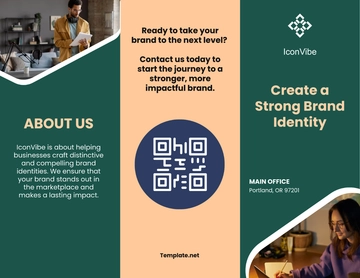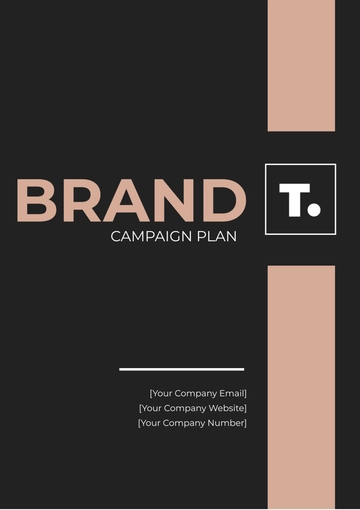Free Branding Creative Brief

1. Objective
The primary goal is to develop a compelling and cohesive brand identity for [Your Client Name] that distinctly resonates with their target audience while ensuring a notable presence in a competitive market. This entails crafting a unique and memorable logo that visually encapsulates the essence of the brand, alongside a meticulously chosen color palette that reflects the brand’s personality and appeals to its audience. Typography will be selected to enhance readability and convey the brand’s tone, whether it's modern, traditional, or playful. Comprehensive brand guidelines will be created to ensure consistency in all visual and verbal communications, including logo usage, color schemes, typography, and imagery. This strategic approach will help establish a strong brand presence, foster recognition, and facilitate deeper connections with the target audience.
2. Target Audience
To effectively target [Your Client Name]'s audience, a detailed profile encompassing key demographics, psychographics, and behavioral characteristics must be developed:
Demographics: This includes age, gender, income level, education, and occupation. For instance, the target demographic might be women aged 25-40, with a college degree and a household income of $60,000-$90,000, working in professional or managerial roles. Understanding these specifics helps tailor branding strategies to appeal directly to this group’s preferences and expectations.
Psychographics: This involves delving into the interests, values, lifestyles, and personality traits of the audience. For example, the audience might prioritize sustainability and ethical practices, enjoy outdoor activities, and value innovative and stylish solutions. These insights inform the brand’s messaging and visual identity to align with the audience's values and lifestyle.
Behavioral Characteristics: Analyze purchasing habits, brand loyalty, and product usage patterns. This could include frequent online shoppers who value convenience and customer service, are likely to engage with brands through social media, and exhibit strong brand loyalty when satisfied with a product. Understanding these behaviors will guide the development of strategies to enhance engagement and foster long-term relationships.
3. Brand Positioning
Brand positioning must be articulated clearly to distinguish [Your Client Name] from competitors. This involves defining the brand's unique value proposition, which is a succinct statement of the brand’s unique benefits and offerings. For instance, [Your Client Name] may position itself as the go-to provider of eco-friendly, high-quality products designed to enhance everyday life. The positioning statement should encapsulate this proposition in a way that highlights key differentiators, such as superior craftsmanship, innovative design, or exceptional customer service. By clearly defining these elements, the brand can effectively communicate its unique strengths and appeal directly to its target audience.
4. Key Messages
Develop a series of core messages to consistently convey the brand’s mission, vision, and values across all communication channels:
Mission: Define what [Your Client Name] aims to achieve. For example, “Our mission is to provide innovative, sustainable solutions that enhance everyday living while fostering a commitment to environmental stewardship.”
Vision: Articulate the long-term aspiration of the brand. This might be, “We envision a world where our products set the standard for quality and sustainability, leading the industry in responsible innovation.”
Values: Outline the principles and beliefs guiding the brand. Values could include integrity, sustainability, customer-centricity, and innovation. For instance, “We believe in integrity in all our business practices, a commitment to environmental sustainability, and continuously innovating to exceed our customers’ expectations.”
5. Deliverables
Include a timeline for the creation and delivery of the logo, brand guidelines, website design, marketing materials, and any other collateral needed.
Phase | Deliverable | Timeline |
|---|---|---|
Phase 1 | Logo Design | 2 weeks |
Phase 2 | Brand Guidelines | 4 weeks |
Phase 3 | Website Design | 6 weeks |
Phase 4 | Marketing Materials | 3 weeks |
6. Budget
Provide a detailed budget breakdown, outlining costs associated with each phase of the project, including design, production, and implementation.
Phase | Cost |
|---|---|
Design | $5,000 |
Production | $3,000 |
Implementation | $2,000 |
Total | $10,000 |
7. Metrics for Success
Establish clear metrics for measuring the effectiveness of the branding efforts, such as brand recognition, customer engagement, and sales growth, to ensure alignment with [Your Client Name]'s business objectives.
Brand Recognition: Increase in brand recall and presence.
Customer Engagement: Improved interaction and feedback from customers.
Sales Growth: Increase in revenue and market share.
8. Contact Information
Name: [Your Name]
Email: [Your Email]
[Your Company Name]
Number: [Your Company Number]
Address: [Your Company Address]
Website: [Your Company Website]
Social Media: [Your Company Social Media]
- 100% Customizable, free editor
- Access 1 Million+ Templates, photo’s & graphics
- Download or share as a template
- Click and replace photos, graphics, text, backgrounds
- Resize, crop, AI write & more
- Access advanced editor
The Branding Creative Brief Template on Template.net offers a comprehensive, customizable framework for your projects. Editable to suit any branding needs, this template ensures clarity and creativity in your briefs. Maximize your efficiency with our fully customizable and editable template, specifically designed to be seamlessly editable in our Ai Editor Tool. Enhance your branding strategy today!





























